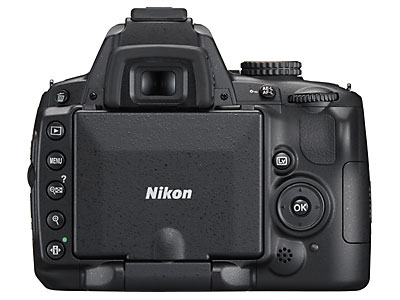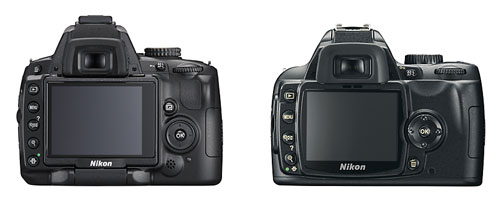The D5000 is the latest camera in Nikon’s entry level line of DSLRs. The camera inherits some of the D90’s features but keeps things simplified for beginners. It’s also the first camera in the Nikon line to feature an articulating LCD screen. I had the opportunity to play with the D5000 for a few days. Continue reading to see how it shapes up.
Editors Note: This is by no means an exhaustive review but merely my observations on the new camera.
Body
Unlike the last jump in this lineup from the D40 to the D60, the D5000 has had some revisions to the body design. The most obvious is the 2.7″ swiveling LCD screen. The screen flips out and can be positioned below the body or on back of the camera. The swiveling gives some versatility with the live view, and you can almost think of it as a digital waist-level finder.


D5000 Back
I did, however, encounter a problem with the LCD when using a tripod. I used two different tripod heads and both of them restricted the movement of the LCD screen while mounted. Both of these heads used the fairly common Manfrotto RC2 quick release plate. The lack of swiveling seems to differ on a head by head basis, because I didn’t have the problem when trying it on a ball head. It’s still something to be aware of, and I’m sure it will be addressed in the next revision of the series.
The design of the body itself feels just a little bulkier than its predecessor, the D60. The camera also seems to have inherited the slightly higher prism/flash housing similar to the D90 and D700. Even though the body is small, it feels very comfortable in your hand. There’s no question that it feels like a Nikon.
The D5000 uses roughly the same size pentamirror (not pentaprism) viewfinder as its predecessors. The good news is the basic 3-point AF system has been upgraded to the 11-point Multi-CAM 100 AF system from the D90. In my opinion, this makes the D5000 a much more viable candidate against its closest competition, Canon’s Digital Rebel series of cameras.
Controls


D5000 Controls vs D60 Controls
Nikon has taken the “If it ain’t broke, don’t fix it” approach to the D5000’s controls. For the most part, everything is in about the same place as it was on the D40/60 line of cameras. The biggest changes are the addition of a Live View button and the rear INFO button is now dedicated rather than shared with the magnify button. If you’re used to any of the current Nikons, the latter change is a little confusing at first when playing back your images because you’ll have a tendency to hit the INFO instead of the magnify button.
Menus
The Information display is something D5000 users will become very familiar with. It’s still very easy to navigate, and can be accessed by pressing the INFO button twice. Most of what you’ll want to change on the fly is found in this menu, like the White Balance, ISO, release modes, AF-type and picture controls.
The menu system in the D5000 has been slightly tweaked to resemble that of the D90. The menu hierarchy is broken down into categories (autofocus, exposure, timers, etc.), making it a little easier to find exactly what you’re looking for.
Performance
If the D90 was the little brother to the D300, then the D5000 is definitely the younger sibling of the two. The image quality of the D5000 seemed to be almost identical to the D90, which should come as no surprise since they both use the same low-noise CMOS image sensor. You also get the same Picture Control functionality that is present in all of the recent Nikons.
The pentamirror Autofocus system performs very well, and I didn’t encounter any problems while I was testing the camera. AF in Live View seems to be slightly improved over the D90 but is still a little sluggish in comparison to some of the competition.
Perhaps one of my favorite additions is a minor one, the quiet release mode. I’m sure anyone who has used an SLR knows that the mirror slap can be very loud and obtrusive in some situations. In the quiet mode, the camera reduces the sound of both the shutter and mirror. You can also hold down the shutter after the exposure to delay the release of the mirror. This was a pretty common feature on many film cameras, and I hope it will find its way into the next wave of Nikon DSLRs.
Another first for a Nikon DSLR is the addition of scene modes, reminiscent of most point and shoot cameras. This may seem kind of foolish to experienced users, but I think these modes will help make the D5000 more accessible to beginners. I toyed around with a few of them and while they don’t do a perfect job, they make things a little easier for beginners.
Images
Here are a series of JPEG images directly from the D5000.


Nikon D5000, 10-24mm f/3.5-4.5, 1/400 sec @ f/8, ISO 200


Nikon D5000, 16-85mm f/3.5-5.6 VR, 1/500 sec @ f/8, ISO 200


Nikon D5000, 16-85mm f/3.5-5.6 VR, 1/6 sec @ f/4.5, ISO 3200


Nikon D5000, 16-85mm f/3.5-5.6 VR, 1/15 sec @ f/4.2, ISO 1600


Nikon D5000, 16-85mm f/3.5-5.6 VR, 1/15 sec @ f/4, ISO 1600


Nikon D5000, 16-85mm f/3.5-5.6 VR, 1/25 sec @ f/5.6, ISO 1600


Nikon D5000, 16-85mm f/3.5-5.6 VR, 1/25 sec @ f/8, ISO 200


Nikon D5000, 16-85mm f/3.5-5.6 VR, 1/125 sec @ f/10, ISO 200
Conclusion
Consumers may have a tough choice when picking a Nikon since there are now three entry-level DSLRs. In addition, the D5000 competes heavily with the D90 since the core feature sets are nearly identical. Here are my personal recommendations on who should pick which camera.
First-Time DSLR Users: Unless you’re on a limited budget, I’d definitely pick the D5000. New features like the Live View, Scene modes and Movie mode are all features that will make those moving up from a compact camera feel somewhat at home. At the same time, advanced functions like a better autofocus system, better high ISO performance, and the new picture control system give a little more room for expansion than other “entry-level” Nikon offerings.
D40/D60 Users Looking to Upgrade: Users in this group are probably the most interested in what the D5000 has to offer over their current model. While the camera does offer some nice new features over its predecessors, I would say users looking to grow would be better off taking the next step and moving to a D90 (or even a D300). However, users who still want something small, lightweight and easy to use would most likely be fine with a D5000.
SLR Users Looking for a Lightweight Backup/Fun Camera: Paired with something like an AF-S 50mm f/1.4G or 35mm f/1.8G DX, the D5000 makes an awesome walk-around camera with a lot of versatility. If you own some of the bigger DSLRs and want a smaller rig you can take around, the D5000 is a very viable option. Even if you don’t have auto-focus lenses, the focus confirmation makes manual focusing a little easier.
The D5000 is without a doubt a great addition to the Nikon line-up. It builds on the success of the easy-to-use D40/D60 series camera, while finally adding some features to put it more in-line with the competition.
